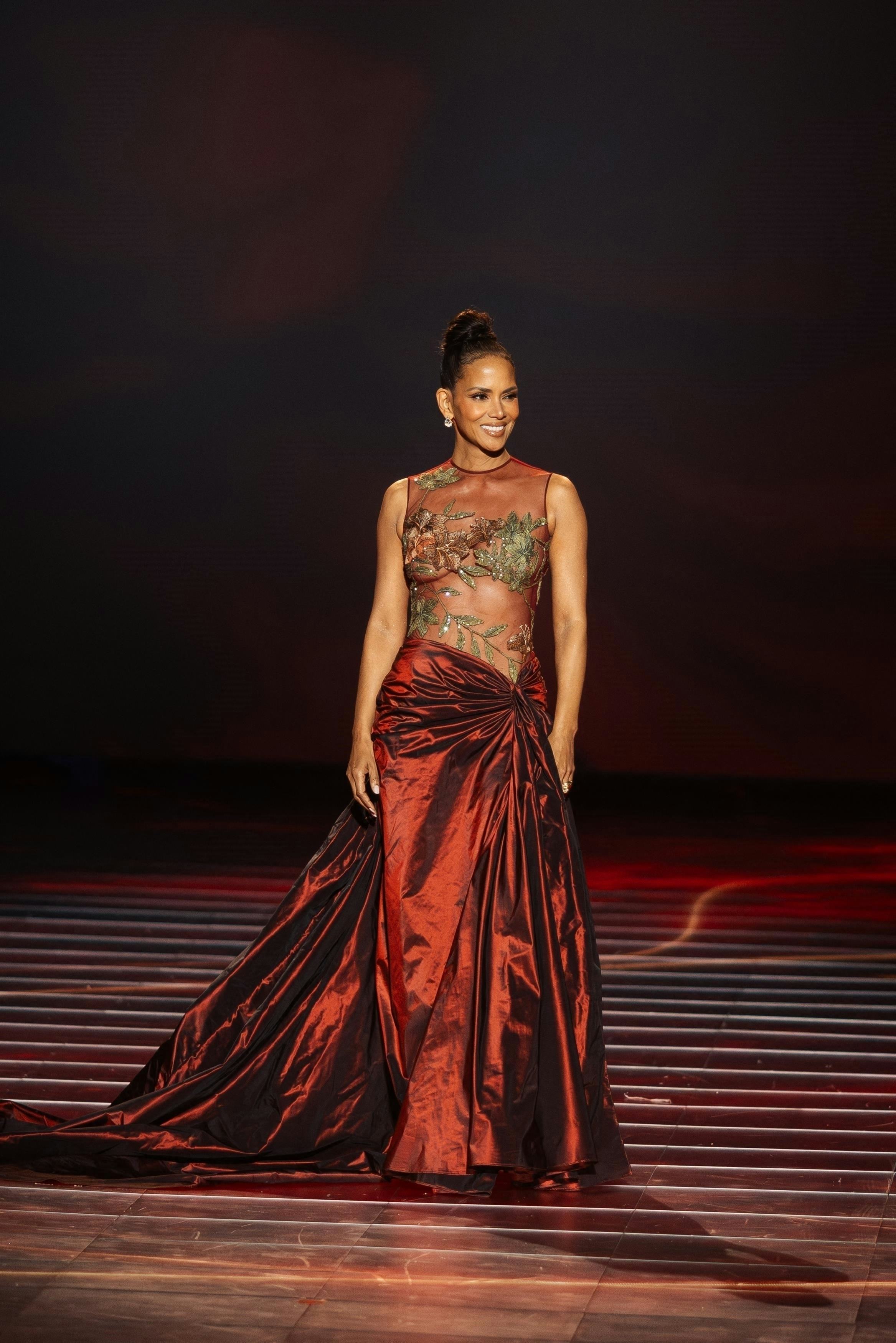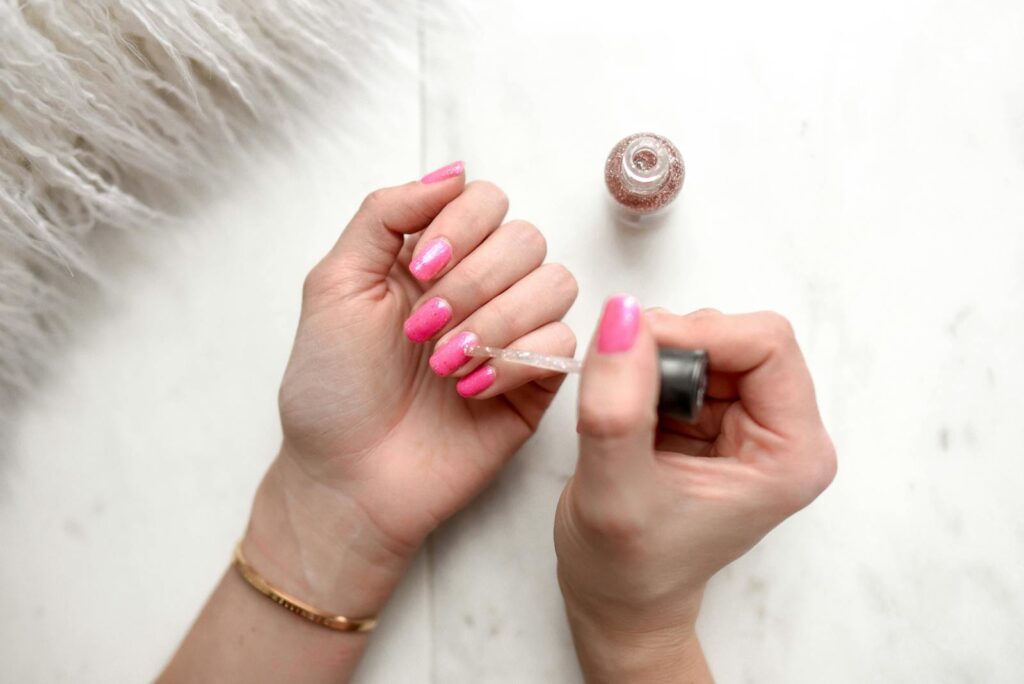:max_bytes(150000):strip_icc():focal(749x0:751x2)/halle-berry-oscars-dress-031023-f82382d658604ad48ed3917ef5a8a26c.jpg)
When Halle Berry first stepped onto the Oscars red carpet in 2002, the world collectively gasped. It wasn’t just the sheer elegance of her Elie Saab gown, with its intricate floral applique bodice, daring sheer mesh, and rich burgundy satin skirt—it was the historic moment that the dress came to embody. That night, Halle Berry became the first Black woman to win the Academy Award for Best Actress, a milestone that transcended fashion and resonated deeply with audiences around the world.
Her gown was more than just a striking ensemble; it became a symbol of triumph and possibility. The unique design, with “strategically placed embroidered flowers and leaves,” perfectly mirrored the delicate balance of strength and vulnerability that Halle brought to her performance in *Monster’s Ball*. The gown itself was a masterpiece, embracing both sensuality and grace, and it stood out as one of the most memorable looks in Oscar history.
For Halle, the gown was deeply personal. As she shared on Instagram years later, “Winning an Academy Award in my @eliesaabworld gown was one of those moments for me!” That night, she made history, and her sartorial choice cemented itself as a timeless piece of cultural and fashion lore.
But the gown didn’t just stop at being a beautiful memory. Over the years, it gained legendary status, appearing on display at the Academy Museum as a testament to its significance. It became a visual reminder of the barriers Halle broke in the entertainment industry and the glaring underrepresentation of Black women in the Oscars’ Best Actress category—a fact Halle herself candidly acknowledged in interviews. “I’m still eternally miffed that no Black woman has come behind me for that Best Actress Oscar,” she told Marie Claire in September. “It’s certainly not because there has been nobody deserving.”

The dress also marked an important moment for Elie Saab as a designer. Before Halle’s victory, Saab was relatively unknown on the global stage. Her choice to wear his creation not only elevated his career but also brought a new level of visibility to the world of haute couture. “She literally put that designer on the award show scene with that dress,” one fan wrote, highlighting just how transformative the moment was for both Berry and Saab.
Fast forward to 2024, and the gown once again made headlines—but this time, it wasn’t just hanging in a museum or being discussed as a relic of red carpet history. Halle Berry herself brought it back to life, re-wearing the iconic dress at the “1001 Seasons of Elie Saab” fashion show in Riyadh, Saudi Arabia. This wasn’t merely a nostalgic gesture; it was a powerful statement about sustainability, legacy, and the enduring impact of truly iconic fashion.
In an era where celebrity culture often emphasizes novelty and excess, Halle’s decision to re-wear her 22-year-old gown felt refreshingly authentic and deeply meaningful. It was a move that echoed the eco-conscious trend of wardrobe recycling, a practice that has gained traction among modern-day royalty like Princess Kate Middleton and Meghan Markle. Halle joined the ranks of high-profile figures who value the stories their clothes tell, proving that great fashion doesn’t have an expiration date.
Halle’s choice also reminded fans of the timelessness of true elegance. “Bodies change, and trends change,” one fashion editor noted, “but this shouldn’t be a reason not to treasure and re-wear old clothes.” For Halle, the gown wasn’t just something she wore—it was something she lived in, something that carried the weight of her journey and her achievements. Her ability to step back into it, both literally and figuratively, showcased her confidence, grace, and undeniable star power.

Of course, the decision to re-wear such a significant piece wasn’t without its challenges. Over two decades had passed since Halle first wore the dress, and yet she managed to make it look just as stunning as ever. In 2002, she paired the gown with a pixie cut, a signature look that she revealed helped her land roles early in her career. “When I got this haircut, I felt like my best self,” she told InStyle. For the 2024 runway show, she opted for a sleek high-top hairstyle, styled into a voluminous bun, adding a modern twist to the nostalgic look.
Halle’s fans were quick to celebrate her triumphant return to the gown. Social media was ablaze with comments praising her “ageless beauty” and the emotional resonance of her decision. “She never ages! Just glides through the aging process with grace and beauty! FACE CARD NEVER DECLINES!!!!!” one admirer gushed. Others pointed out the significance of her choice, with comments like, “She literally put that designer on the award show scene with that dress, and it’s my favorite of all time.”
The impact of Halle’s gown extends far beyond its fabric and design. It serves as a reminder of how fashion can encapsulate moments of personal and cultural significance. It’s not just about looking good; it’s about feeling connected to a moment in time, to a memory, to an achievement. Halle’s decision to re-wear the gown highlighted her ability to embrace her past while continuing to inspire future generations.
In re-wearing her Oscar-winning gown, Halle Berry didn’t just revive a piece of fashion history—she reinforced the power of storytelling through style. Her choice was a celebration of her journey, of her connection to Elie Saab, and of the legacy she continues to build. It was a moment of nostalgia wrapped in glamour, a reminder that the stories we carry with us can shine just as brightly as they did the first time.




